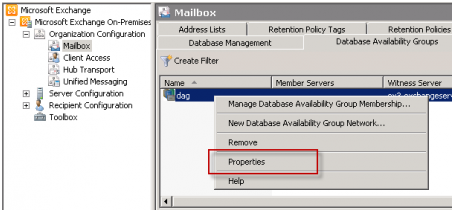Get A List Of Maibox Databases In Each Dag Exchange 2010
Exchange 2010 introduced the database availability group (DAG), which enables you to design a mailbox resiliency configuration that is essentially a redundant array of independent Mailbox servers. Multiple copies of each mailbox database are distributed across these servers to enable mailboxes to remain available during one or more server.
- Get A List Of Mailbox Databases In Each Dag Exchange 2010 Full
- Get Mailbox Database Guid
- Move Mailbox Database Exchange 2010
i am trying to customize my query so that the result show only mailboxes which are 5mb or less
Get-MailboxStatistics -database ' Sort totalitemsize -desc select displayname,totalitemsize
2 Answers
Get A List Of Mailbox Databases In Each Dag Exchange 2010 Full
Shay LevyShay LevyProblem is, Get-MailboxStatistics output just a display name - not unique and cant really be used as such. The other half of the information you need is in Get-Mailbox :- found answer in following link. once you have the data on all your mailboxes, and the output can be IMPORTED into excel you can do all your sorting etc and delete whatever you dont want
if this is what you were looking for, please click this link and give the guy some credit.. i didnt come up with this, i just found it
go to AD and pull all users *view advanced features add column exchange mailbox store, email addresscombine both these lists in excel and enjoy a smile and a coke... you just finished 1 week of work in under 20 minutes
J. SteenNot the answer you're looking for? Browse other questions tagged powershell or ask your own question.
How to export a list of mailbox user names with their mailbox size and item count in decending order.
3 Steps total

Step 1: Login to your Exchange 2010 server
Step 2: Run Exchange PowerShell as Administrator
Step 3: Run PowerShell string
Get Mailbox Database Guid
Get-MailboxStatistics -Database 'Mailbox Database XXXXXXXXXXXXX' Select DisplayName, ItemCount, TotalItemSize Sort-Object TotalItemSize -Descending Export-CSV C:MBSizes.csv
Alter the mailbox database number and the export address as required.
Move Mailbox Database Exchange 2010
If you found this How-to useful, don't forget to spice it up!
49 Comments
- Pure CapsaicinJustin.Davison May 18, 2012 at 08:25am
A script I use regularly, and a great example of how Powershell makes things easy to manage in Exchange 2010. Thanks for posting.
- CayennePickle May 24, 2012 at 04:28pm
Nice!
Thanks - PoblanoPLab Jun 6, 2012 at 09:48am
I replaced the -Database with -Server to get all mailboxes in my org. Works great! Thanks for putting this here. I searched google for a half hour not finding the correct syntax.
- Thai PepperNelson9480 Jun 6, 2012 at 10:38am
Thanks for the comments guys; it's one of those things which used to be so easy to find in the GUI of Exchange 2003 but then totally disappeared into PowerShell in 2010. Took me an age to find so I'm happy to share the knowledge!
- PoblanoTravos Jun 8, 2012 at 11:22am
Wow..microsoft took the one of the most useful things out of exchange and replaced it with a shell command. My god...they are as bad as everyone says.
So instead of simply clicking on a column addition...i know have to spend 5 or 10 minutes researching everyone few months on how to do this. Man...I wish I could meet this guy whose idea this was face to face... - AnaheimDirkSlab Jun 12, 2012 at 08:23am
Thanks!
- Pimientochijioke_amadi Aug 10, 2012 at 11:50am
Thanks..... so easy with all these explanations. Cool.
- PimientoRaul Chavez Sep 26, 2012 at 01:19pm
Excelente, funciona perfecto, muchas gracias......
- Ghost ChiliNick42 Dec 18, 2012 at 07:18am
Sweet!
- PimientoSaid2067 Jan 3, 2013 at 05:51pm
slick. Thanks.
- Macemolan Jan 7, 2013 at 03:24pm
Exactly what I needed Thanks!
- PimientoBrianMcD Jan 9, 2013 at 01:57am
This was excellent. Thank you!
- PimientoEllen3429 Jan 31, 2013 at 12:23am
Thank you, worked like a charm :-)
- PoblanoTony_Spearmark Apr 12, 2013 at 10:53am
Thanks you loads, this is exactly what I needed. Perfect :o)
- Pimientoknowledge Adv Apr 23, 2013 at 08:41am
Thank you finally I found what I was looking for . perfect
- 1
- 2
- 3
- 4